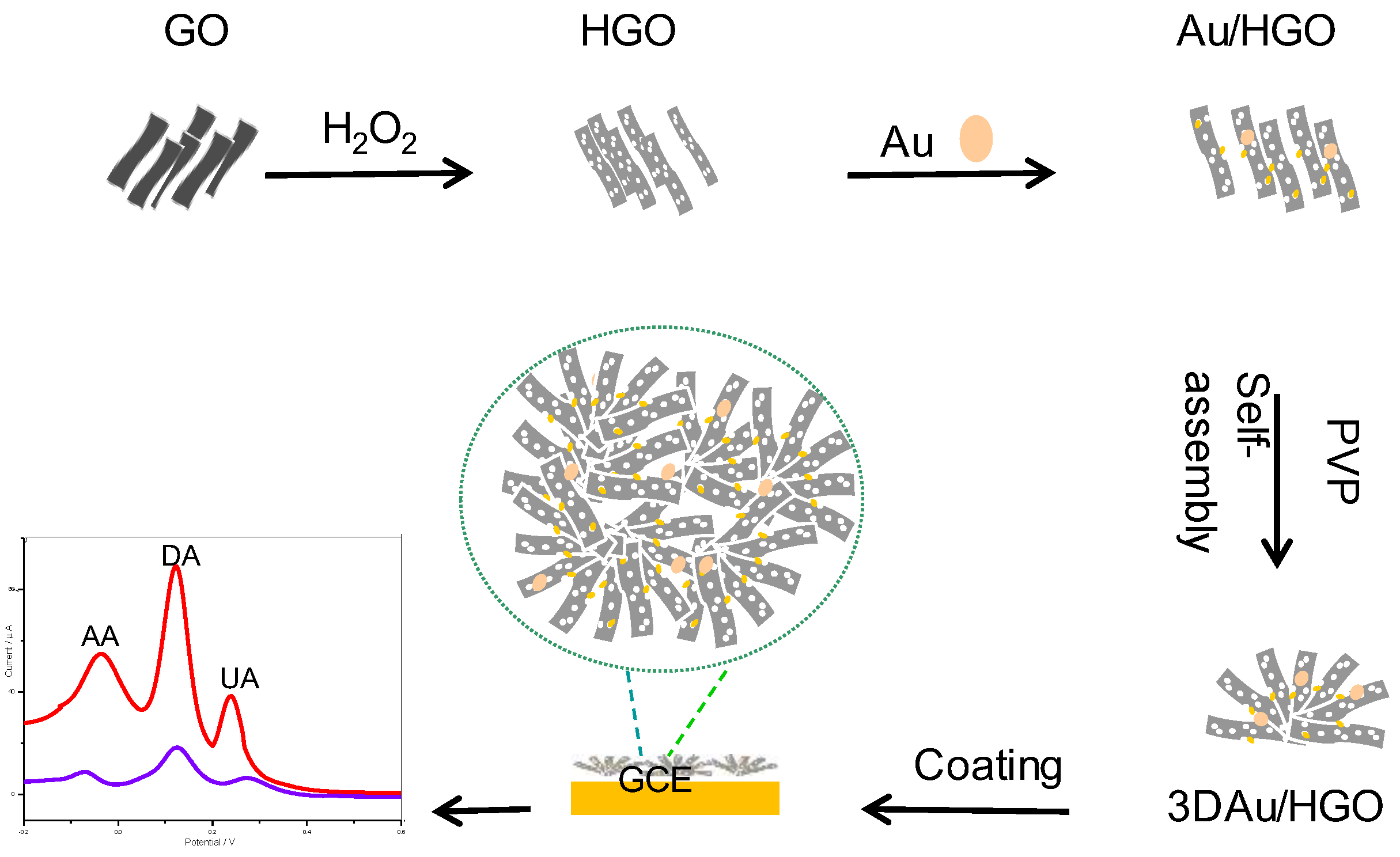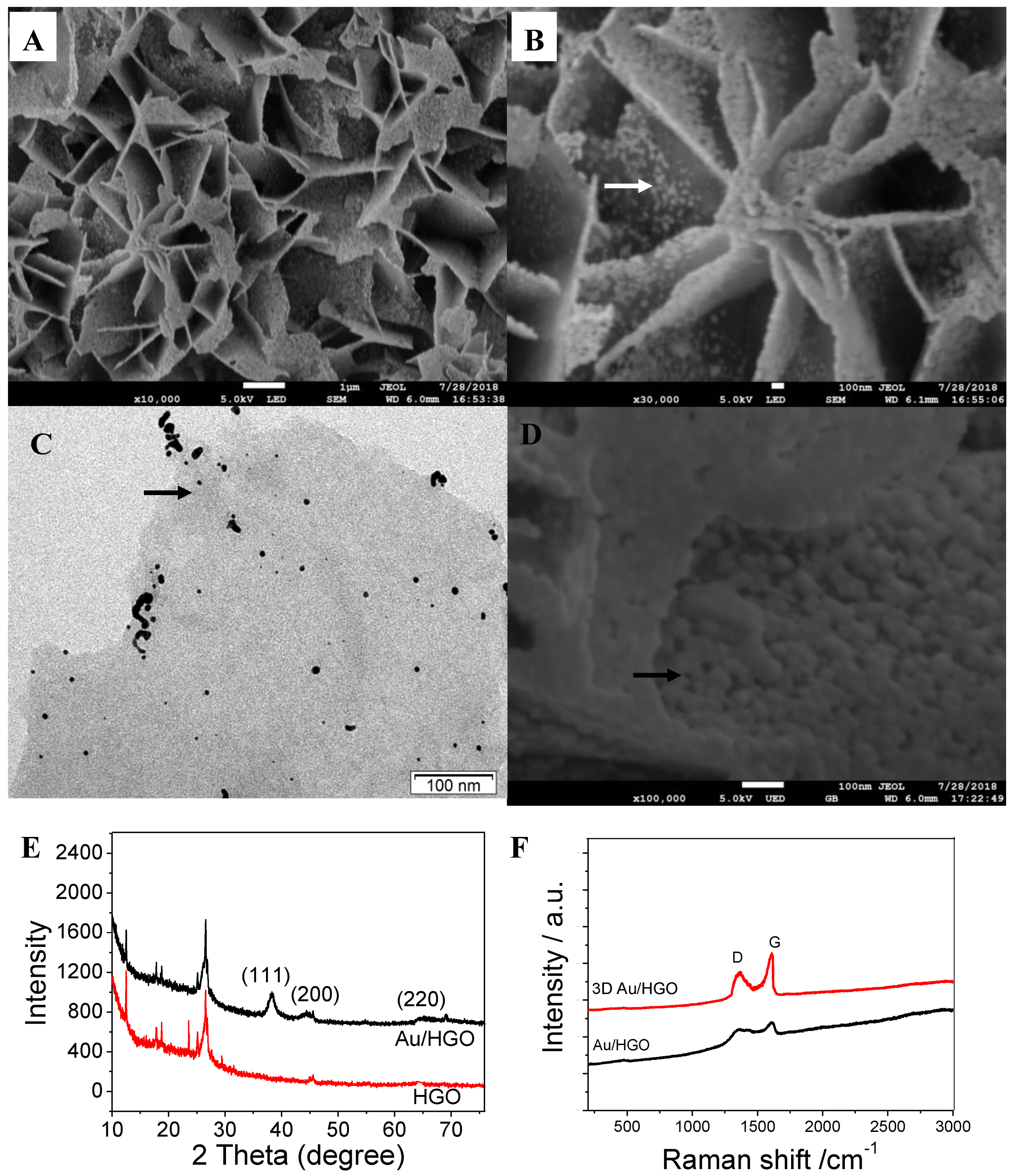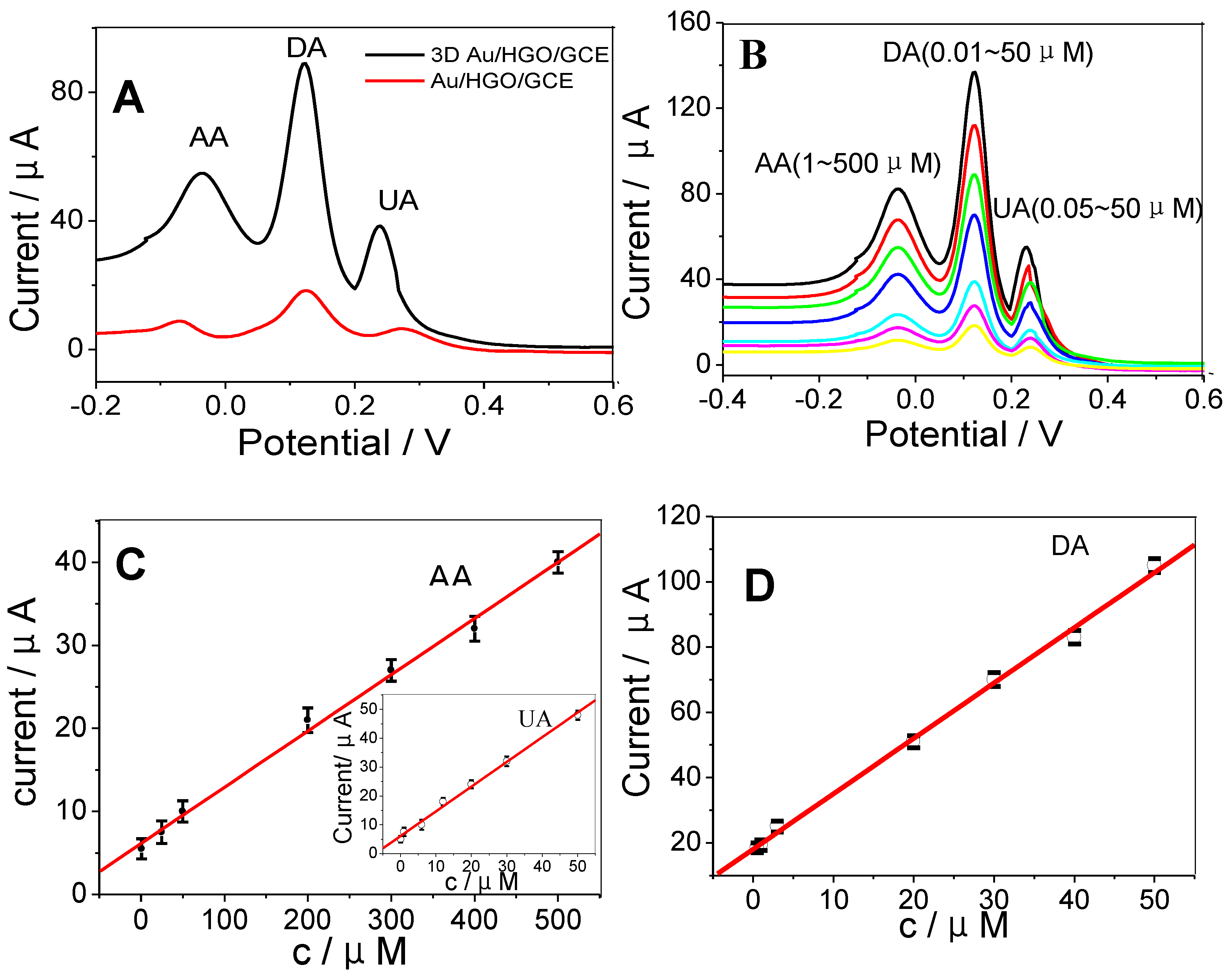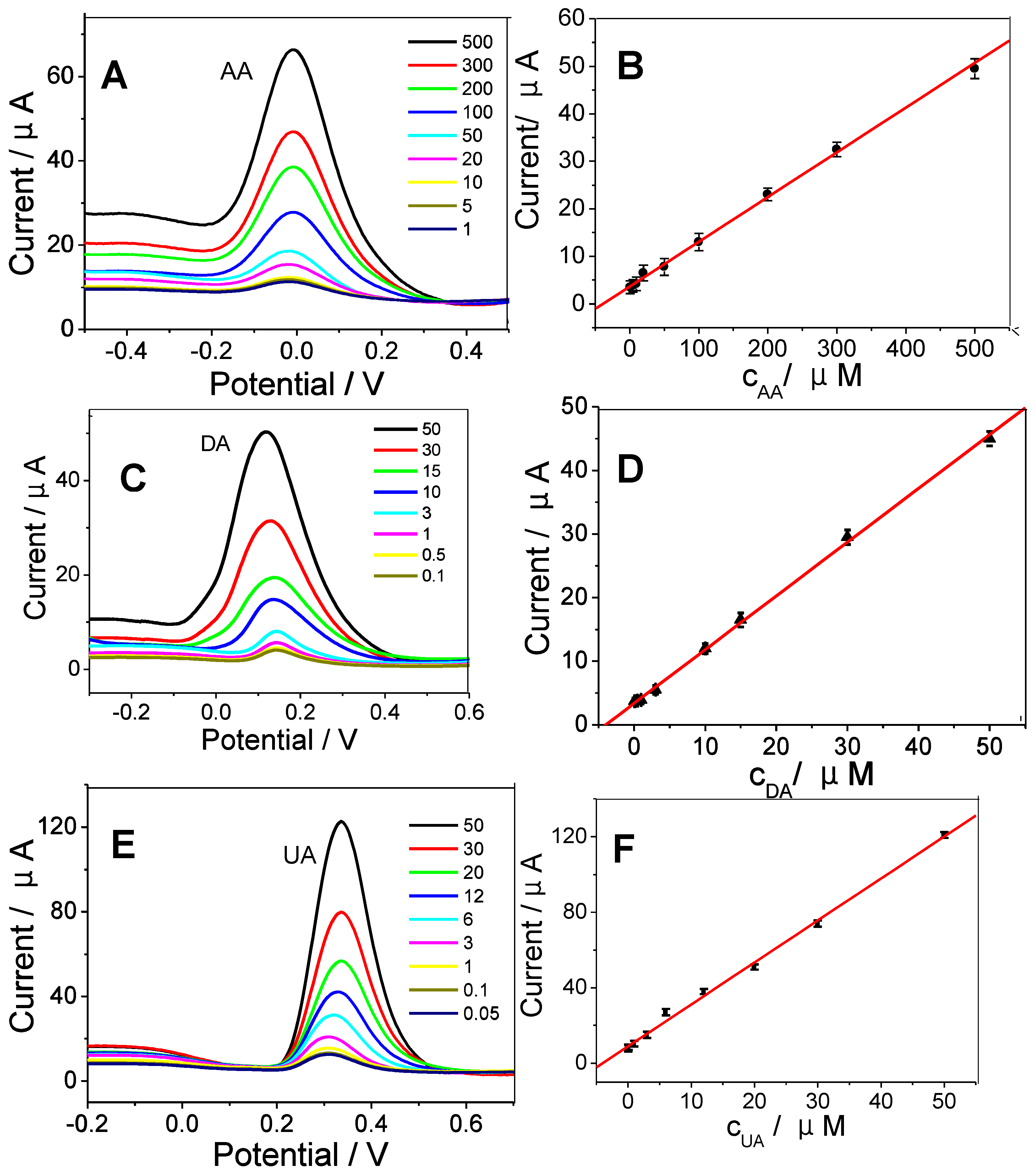Three-Dimensional Au/Holey-Graphene as Efficient Electrochemical Interface for Simultaneous Determination of Ascorbic Acid, Dopamine and Uric Acid
Abstract
:1. Introduction
2. Materials and Methods
2.1. Regents and Apparatus
2.2. Preparation of Holey Graphene Oxide (HGO)
2.3. Preparation of Polyvinyl Pyrrolidone (PVP)-Protected Au Colloids
2.4. Synthesis of Au/Holey Graphene Oxide (Au/HGO)
2.5. Preparation of PVP/Au/HGO
2.6. Preparation of 3D Au/HGO Modified Glassy Carbon Electrode (3D Au/HGO/GCE)
3. Results
3.1. Characterization of 3DAu/HGO
3.2. 3DAu/HGO for the Electrochemical Determination of AA, DA, and UA
3.3. Real Sample Analysis
4. Conclusions
Supplementary Materials
Author Contributions
Funding
Conflicts of Interest
References
- Wang, X.; Zheng, K.; Feng, X.; Xu, C.; Song, W. Polymeric ionic liquid functionalized MWCNTs as efficient electrochemical interface for biomolecules simultaneous determination. Sens. Actuators B Chem. 2015, 219, 361–369. [Google Scholar]
- Reddy, Y.V.M.; Rao, V.P.; Reddy, A.V.B.; Lavanya, M.; Venu, M.; Lavanya, M.; Madhavi, G. Determination of dopamine in presence of ascorbic acid and uric acid using poly (Spands Reagent) modified carbon paste electrode. Mater. Sci. Eng. C Mater. Biol. Appl. 2015, 57, 378–386. [Google Scholar] [CrossRef]
- Oliveira, A.X.; Silva, S.M.; Leite, F.R.F.; Kubota, L.T.; Damos, F.S.; Luz, R.d.C.S. Highly Sensitive and Selective Basal Plane Pyrolytic Graphite Electrode Modified with 1,4-Naphthoquinone/MWCNT for Simultaneous Determination of Dopamine, Ascorbate and Urate. Electroanalysis 2013, 25, 723–731. [Google Scholar] [CrossRef]
- Gong, T.; Liu, J.; Wu, Y.; Xiao, Y.; Wang, X.; Yuan, S. Fluorescence enhancement of CdTe quantum dots by HBcAb-HRP for sensitive detection of H2O2 in human serum. Biosens. Bioelectron. 2017, 92, 16–20. [Google Scholar] [CrossRef]
- Shan, X.Y.; Chai, L.J.; Ma, J.J.; Qian, Z.S.; Chen, J.R.; Feng, H. B-doped carbon quantum dots as a sensitive fluorescence probe for hydrogen peroxide and glucose detection. Analyst 2014, 139, 2322–2325. [Google Scholar] [CrossRef]
- Komagoe, K.; Katsu, T. Porphyrin-induced photogeneration of hydrogen peroxide determined using the luminol chemiluminescence method in aqueous solution: A structure-activity relationship study related to the aggregation of porphyrin. Anal. Sci. Int. J. Jpn. Soc. Anal. Chem. 2006, 22, 255–258. [Google Scholar] [CrossRef]
- Liu, J.; Bo, X.; Zhao, Z.; Guo, L. Highly exposed Pt nanoparticles supported on porous graphene for electrochemical detection of hydrogen peroxide in living cells. Biosens. Bioelectron. 2015, 74, 71–77. [Google Scholar] [CrossRef]
- Huang, J.; Liu, Y.; Hou, H.; You, T. Simultaneous electrochemical determination of dopamine, uric acid and ascorbic acid using palladium nanoparticle-loaded carbon nanofibers modified electrode. Biosens. Bioelectron. 2009, 24, 632–637. [Google Scholar] [CrossRef]
- Joshi, A.; Schuhmann, W.; Nagaiah, T.C. Mesoporous nitrogen containing carbon materials for the simultaneous detection of ascorbic acid, dopamine and uric acid. Sens. Actuators B Chem. 2016, 230, 544–555. [Google Scholar]
- Yang, Y.J. One-pot synthesis of reduced graphene oxide/zinc sulfide nanocomposite at room temperature for simultaneous determination of ascorbic acid, dopamine and uric acid. Sens. Actuators B Chem. 2015, 221, 750–759. [Google Scholar]
- Cai, W.; Lai, J.; Lai, T.; Xie, H.; Ye, J. Controlled functionalization of flexible graphene fibers for the simultaneous determination of ascorbic acid, dopamine and uric acid. Sens. Actuators B Chem. 2016, 224, 225–232. [Google Scholar]
- Vicentini, F.C.; Raymundo-Pereira, P.A.; Janegitz, B.C.; Machado, S.A.S.; Fatibello-Filho, O. Nanostructured carbon black for simultaneous sensing in biological fluids. Sens. Actuators B Chem. 2016, 227, 610–618. [Google Scholar]
- Yue, H.Y.; Huang, S.; Chang, J.; Heo, C.; Yao, F.; Adhikari, S.; Gunes, F.; Liu, L.C.; Lee, T.H.; Oh, E.S.; et al. ZnO nanowire arrays on 3D hierachical graphene foam: biomarker detection of Parkinson’s disease. ACS Nano 2014, 8, 1639–1646. [Google Scholar] [CrossRef]
- Zhu, Q.; Jing, B.; Huo, D.; Mei, Y.; Hou, C.; Guo, J.; Mei, C.; Fa, H.; Luo, X.; Yi, M. 3D Graphene hydrogel—Gold nanoparticles nanocomposite modified glassy carbon electrode for the simultaneous determination of ascorbic acid, dopamine and uric acid. Sens. Actuators B Chem. 2017, 238, 1316–1323. [Google Scholar]
- Yu, B.; Song, J.; Yan, M.; Han, D.; Fan, Y.; Li, N.; Ivaska, A. Graphene Oxide-Templated Polyaniline Microsheets toward Simultaneous Electrochemical Determination of AA/DA/UA. Electroanalysis 2011, 23, 878–884. [Google Scholar]
- Zhang, L.; Zhang, J. 3D hierarchical bayberry-like Ni@carbon hollow nanosphere/rGO hybrid as a new interesting electrode material for simultaneous detection of small biomolecules. Talanta 2018, 178, 608–615. [Google Scholar] [CrossRef]
- Wu, L.; Feng, L.; Ren, J.; Qu, X. Electrochemical detection of dopamine using porphyrin-functionalized graphene. Biosens. Bioelectron. 2012, 34, 57–62. [Google Scholar] [CrossRef]
- Zhao, L.; Li, H.; Gao, S.; Li, M.; Sheng, X.; Li, C.; Guo, W.; Qu, C.; Yang, B. MgO nanobelt-modified graphene-tantalum wire electrode for the simultaneous determination of ascorbic acid, dopamine and uric acid. Electrochim. Acta 2015, 168, 191–198. [Google Scholar] [CrossRef]
- Zhu, Q.; Jing, B.; Huo, D.; Mei, Y.; Wu, H.; Hou, C.; Zhao, Y.; Luo, X.; Fa, H. 3DGH-Fc based electrochemical sensor for the simultaneous determination of ascorbic acid, dopamine and uric acid. J. Electroanal. Chem. 2017, 799, 459–467. [Google Scholar] [CrossRef]
- Zhang, L.; Huang, D.; Hu, N.; Yang, C.; Li, M.; Wei, H.; Yang, Z.; Su, Y.; Zhang, Y. Three-dimensional structures of graphene/polyaniline hybrid films constructed by steamed water for high-performance supercapacitors. J. Power Sources 2017, 342, 1–8. [Google Scholar] [CrossRef]
- Zhu, Y.; Zhang, X.; Li, J.; Qi, G. Three-dimensional graphene as gas diffusion layer for micro direct methanol fuel cell. Int. J. Mod. Phys. B 2018, 32, 1850145. [Google Scholar] [CrossRef]
- Loeblein, M.; Bruno, A.; Loh, G.C.; Bolker, A.; Saguy, C.; Antila, L.; Tsang, S.H.; Teo, E.H.T. Investigation of electronic band structure and charge transfer mechanism of oxidized three-dimensional graphene as metal-free anodes material for dye sensitized solar cell application. Chem. Phys. Lett. 2017, 685, 442–450. [Google Scholar] [CrossRef]
- He, D.; Wang, W.; Fu, Y.; Zhao, R.; Xue, W.; Hu, W. Formation of three-dimensional honeycomb-like nitrogen-doped graphene for use in energy-storage devices. Compos. Part A Appl. Sci. Manuf. 2016, 91, 140–144. [Google Scholar] [CrossRef]
- Gethers, M.L.; Thomas, J.C.; Jiang, S.; Weiss, N.O.; Duan, X.; Goddard, W.A.; Weiss, P.S. Holey Graphene as a Weed Barrier for Molecules. Acs Nano 2015, 9, 10909–10915. [Google Scholar] [CrossRef] [PubMed] [Green Version]
- Yang, M.-Q.; Pan, X.; Zhang, N.; Xu, Y.-J. A facile one-step way to anchor noble metal (Au, Ag, Pd) nanoparticles on a reduced graphene oxide mat with catalytic activity for selective reduction of nitroaromatic compounds. Crystengcomm 2013, 15, 6819–6828. [Google Scholar] [CrossRef]
- Wang, X.; Gao, D.; Li, M.; Li, H.; Li, C.; Wu, X.; Yang, B. CVD graphene as an electrochemical sensing platform for simultaneous detection of biomolecules. Sci. Rep. 2017, 7, 7044. [Google Scholar] [CrossRef] [PubMed]
- Xiao, X.; Beechem, T.E.; Brumbach, M.T.; Lambert, T.N.; Davis, D.J.; Michael, J.R.; Washburn, C.M.; Wang, J.; Brozik, S.M.; Wheeler, D.R.; et al. Lithographically defined three-dimensional graphene structures. ACS Nano 2012, 6, 3573–3579. [Google Scholar] [CrossRef]
- Xu, Y.; Chen, C.-Y.; Zhao, Z.; Lin, Z.; Lee, C.; Xu, X.; Wang, C.; Huang, Y.; Shakir, M.I.; Duan, X. Solution processable holey graphene oxide and its derived macrostructures for high-performance supercapacitors. Nano Lett. 2015, 15, 4605–4610. [Google Scholar] [CrossRef]
- Kemal, L.; Jiang, X.C.; Wong, K.; Yu, A.B. Experiment and theoretical study of poly (vinyl pyrrolidone)-controlled gold nanoparticles. J. Phys. Chem. C 2008, 112, 15656–15664. [Google Scholar] [CrossRef]
- Fang, Y.; Guo, S.; Zhu, C.; Zhai, Y.; Wang, E. Self-assembly of cationic polyelectrolyte-functionalized graphene nanosheets and gold nanoparticles: A two-dimensional heterostructure for hydrogen peroxide sensing. Langmuir 2010, 26, 11277–11282. [Google Scholar] [CrossRef]
- Deng, W.; Yuan, X.; Tan, Y.; Ma, M.; Xie, Q. Three-dimensional graphene-like carbon frameworks as a new electrode material for electrochemical determination of small biomolecules. Biosens. Bioelectron. 2016, 85, 618–624. [Google Scholar] [CrossRef] [PubMed]





| Modified Electrode | Linear Range (μmol·L−1) | Detection Limit (μmol·L−1) | Ref. | ||||
|---|---|---|---|---|---|---|---|
| AA | DA | UA | AA | DA | UA | ||
| Polymer/Multi-walled Carbon Nanotubes | 3.0–1500 | 10–600 | 2.0–60 | 1.65 | 2.01 | 0.46 | [1] |
| Mesoporous Nitrogen/Carbon | 1.0–700 | 0.001–30 | 0.01–80 | 0.01 | 0.001 | 0.01 | [9] |
| Graphene Oxide/Zinc Sulfide | 50–1000 | 1.0–500 | 1.0–500 | 30 | 0.5 | 0.4 | [10] |
| Flexible Graphene Fibers | 200–750 | 1.0–13 | 10–260 | 50 | 0.1 | 0.2 | [11] |
| Carbon Black | 1.02–20.2 | 0.9–18.6 | 0.79–11.7 | 0.008 | 0.117 | 0.138 | [12] |
| 3DAu/HGO | 1.0–500 | 0.01–50 | 0.05–50 | 0.1 | 0.005 | 0.01 | This work |
| Samples | Added (μM·L−1) | Found (μM·L−1) | Recoveries (%) | ||||||
|---|---|---|---|---|---|---|---|---|---|
| AA | DA | UA | AA | DA | UA | AA | DA | UA | |
| Serum 1 | 10.00 | 1.00 | 5.00 | 10.19 | 9.81 | 5.19 | 101.9 | 98.1 | 103.8 |
| Serum 2 | 30.00 | 5.00 | 10.00 | 31.80 | 5.12 | 9.93 | 106.0 | 102.4 | 99.3 |
| Serum 3 | 150.00 | 30.00 | 30.00 | 142.05 | 30.35 | 28.86 | 94.7 | 101.2 | 96.2 |
© 2019 by the authors. Licensee MDPI, Basel, Switzerland. This article is an open access article distributed under the terms and conditions of the Creative Commons Attribution (CC BY) license (http://creativecommons.org/licenses/by/4.0/).
Share and Cite
Jing, A.; Liang, G.; Yuan, Y.; Feng, W. Three-Dimensional Au/Holey-Graphene as Efficient Electrochemical Interface for Simultaneous Determination of Ascorbic Acid, Dopamine and Uric Acid. Micromachines 2019, 10, 84. https://doi.org/10.3390/mi10020084
Jing A, Liang G, Yuan Y, Feng W. Three-Dimensional Au/Holey-Graphene as Efficient Electrochemical Interface for Simultaneous Determination of Ascorbic Acid, Dopamine and Uric Acid. Micromachines. 2019; 10(2):84. https://doi.org/10.3390/mi10020084
Chicago/Turabian StyleJing, Aihua, Gaofeng Liang, Yixin Yuan, and Wenpo Feng. 2019. "Three-Dimensional Au/Holey-Graphene as Efficient Electrochemical Interface for Simultaneous Determination of Ascorbic Acid, Dopamine and Uric Acid" Micromachines 10, no. 2: 84. https://doi.org/10.3390/mi10020084
APA StyleJing, A., Liang, G., Yuan, Y., & Feng, W. (2019). Three-Dimensional Au/Holey-Graphene as Efficient Electrochemical Interface for Simultaneous Determination of Ascorbic Acid, Dopamine and Uric Acid. Micromachines, 10(2), 84. https://doi.org/10.3390/mi10020084




